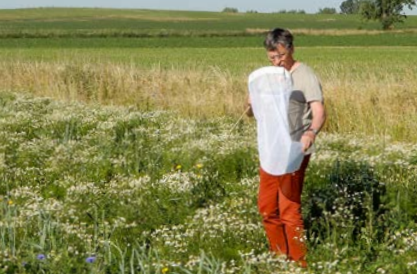Joachim Moens (HoGent) is looking for useful insects such as the ladybird and the hoverfly, which will fight harmful insects such as Lema cyanella and aphids.
Natural enemies of harmful insects
Boerennatuur Vlaanderen (Belgium) has produced a practical guide to the usefulness of flower strips. What functions do they fulfil? What is the best location? How do you sow them? Which flowers can be used? Each chapter goes into the technical aspects of flower strips in more detail.
Chapter 4 is about recognising usefull insects. Here you can find a list of usefull insects, information about what they eat and information on recognising the different stages of the insects.
Practical guide: Flower strips in the fight against pests (Dutch only)
Pollinators
Wild bees
There are more than 350 species of wild bees in Europe. These include both social species (e.g. bumblebees) and solitary species (which raise their own offspring). Pollen and nectar are vitally necessary for these insects. They have a special structure for harvesting pollen (brushes, hives, feathered hairs), which makes them excellent pollinators.
More information about bumblebees and solitary bees can be found at the website of the Beespoke project (common bumblebees leaflet [English, Dutch]) and the SAPOLL project (Dutch and French) respectively.
Hoverflies
See information in the paragraph on natural enemies and on the website of the SAPOLL project (Dutch and French).
Lepidoptera
Lepidoptera are well-known pollinators and popular with the general public. There is a distinction between butterflies (day-active) and moths (mainly night-active). What especially distinguishes Lepidoptera from other pollinating insects is their tongue. These are very long and flexible, and are extremely suitable for collecting nectar from flowers.
Unfortunately, the larvae of these insects often are harmful to several of our crops.
Monitoring techniques
Monitoring or inspection of crops (and fields) not only allows farmers to get information about the status of the crop, but also gives them a good assessment of:
- Which pest and beneficials are active in the field and in which life stage
- What damage is done and whether it exceed the economic threshold (if present for that specific situation)
Armed with this information farmers will be able to choose the right pest management strategy.
Monitoring techniques that can be used to make this assessment are:
- Pitfall trap
- Pheromone trap
- Pan trap
- Sticky trap
- Sweep net
- Visual observation/counts
You can also find these techniques in this practical guide (Dutch only).
1. Pitfall trap
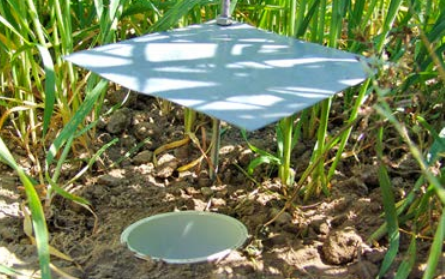
- Location: Pitfall traps can be put in all kinds of vegetation. However, make sure that the trap doesn’t overflow by rain. A little roof at sufficient height (± 2cm) can be a solution.
- Sampling method: To prevent that predatory insects, falling into the trap, will eat the rest of the catch, traps are ideally emptied daily. When this isn’t possible, a liquid (water with soap or a preservative) can be poured into the trap. In this setting traps can be left for 3 à 4 days.
- Benefits: Easy to make and place. Cheap. When emptied daily, no arthropods are harmed.
- Contra: When not placed correctly, nothing will get caught.
2. Pheromone trap
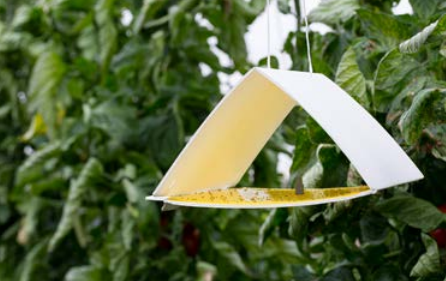
- Location: place the trap near the host plant of the insect that you want to monitor
- Sampling method: Hang the trap before the first flight of the insect that you want to monitor. Baits usually last for a few weeks, so you have to change them in time. You can find this information in the user manual of the trap. Wash your hands after using pheromones or wear rubber gloves, as insects may follow you when you smell like one of their own.
- Benefits: Pheromones are very specific, low risks to catch other insects. Easy to use.
- Contra: Not yet available for every insect.
[1] Pheromones are chemical cues emitted by insects and other arthropods to communicate with each other. There are different kinds of pheromones each with their specific function. For instance, alarm pheromones are used to warn each other in case of danger, sex-pheromones are emitted to attract the opposite sex.
3. Pan trap
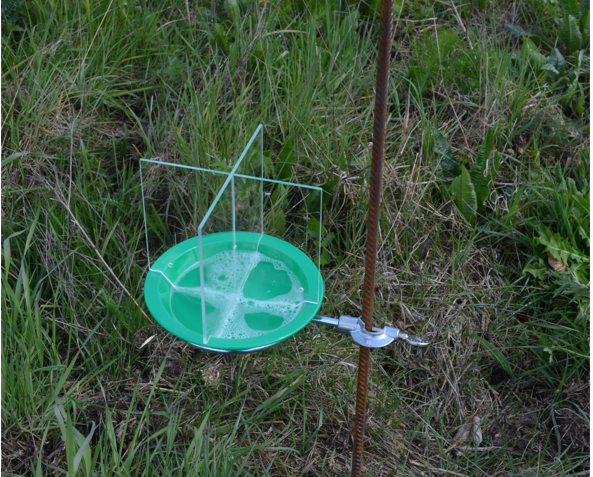
- Location: The desired height of the traps is approximately 40 cm above ground level or 5 cm above the crop height (when the crop height is higher than 40 cm).
- Sampling method: Traps are preferably emptied within 3 à 4 days to prevent trapped insects from decay. If this interval is not possible, a preservative (ethylene glycol, auto antifreeze,...) can be used to extend this time (approximately 7 days).
- Benefits: The trapped arthropods can be easily identified
- Contra: The selectivity of this method can be argued. All kinds of flying insects are attracted. It’s highly labor intensive to find one specific insect in the mass of trapped insects.
4. Sticky trap
Sticky traps are glue-based traps and, depending on the color (yellow or blue), can detect a variety of flying insects. Use blue traps to detect thrips. 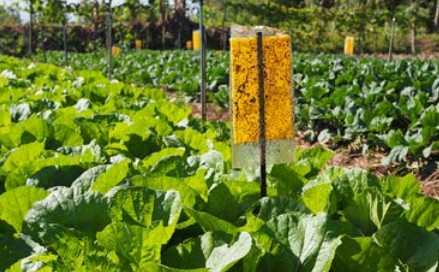
- Location: Hang the traps preferably 20 to 30 cm above the crop.
- Sampling method: Count the trapped insects on a weekly basis. Mark trapped insects to avoid double counts and replace the traps when significant numbers of insects are captured.
- Benefits: Clearly recognizable insects are easy to count with sticky traps.
- Contra: Because of the glue it can be a sticky mess. It’s difficult to identify insects when they are stuck in the glue.
5. Sweep net
A sweep net is a funnel-shaped net (Ø= 30-50 cm) made of a light fabric or mesh (mesh width: ±300 μm) and attached to a long-handled frame. By sweeping the net through the top of the crop or vegetation (flying) insects could be monitored. The captured insects can be counted directly in the net or emptied into a plastic bottle or bag.
- Location: Swing the net through the crop/vegetation canopy, against the wind.
- Sampling method: Avoid sweeping when it’s been raining, when there is too much wind (> 4 Beaufort) or early in the morning when there is still dew. Insects are exothermic (=cold-blooded) and much more active when the sun is shining. Sweep one stroke (=a full 180° arc) per step. At 20 meters you can make approximately 25 strokes.
- Benefits: Insect-friendly: you don’t have to kill the insects, you can count them in the net.
- Contra: This technique is not selective and depending on the weather. Besides that… practice makes perfect.
6. Visual observations/counts
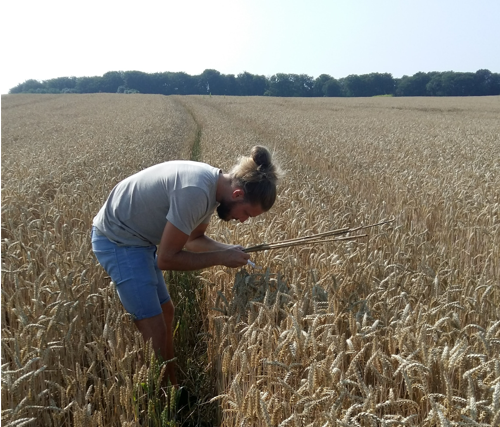
- Location: To ensure accurate sampling select multiple (min.30) plants (or leaves, stems, roots, …) across the whole field or during a set period of time (e.g. 20 minutes for a field of ± 5 ha)
- Sampling method: To have a representative estimate of insect numbers, repeated counts (i.e. 4 to 7 times during the period when target insects are most active) are necessary. Observations preferably occur between 10.00 and 17.00 hours during dry, windless days.
- Benefits: It is a simply, non-destructive method which also gives a good estimate of the average crop growth and health
- Contra: It’s a labor intensive method which require a well-trained eye
